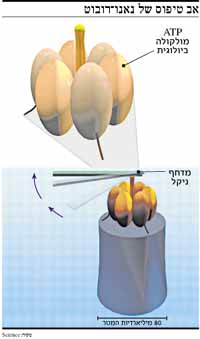Researchers have succeeded in producing an engine that can tour the body and repair damage in cells
"New York Times" and Tamara Traubman

As part of the relentless progress towards ever-increasing miniaturization, they succeeded
Scientists not only build tiny accessories, but also make them move.
In an issue of the journal "Science" published last Friday,
Scientists from "Cornell" University reported that they had assembled a tiny engine, in size
a bacterium, to a metal propeller, and made it move at a speed of up to eight
revolutions per second.
"This is actually the first nano machine," said Carlo Montemagno, a professor
of bioengineering at Cornell University, and the paper's senior author
In "Science" "nano" is a Greek prefix, which means "partial one".
billion". The term "nano-technology" refers to devices of several sizes
Nanometers, that is, several units of one billionth of a meter
(a few billionths of a meter).
The engine's energy source is the same as the body's energy source (molecule
ATP). According to Montemanio, the possibility of building robots has now opened up
The little ones from bacteria, which could repair cellular damage, produce drugs for cells
and attack cancer cells. "This may allow the production of machines that will live in a cell,"
He said, "This allows us to insert engineering instruments into living systems."
The work of the Cornell scientists combines two types of research, which are developing
In recent years in the field of nanotechnology. In the first type, called
Nanotechnology, scientists deal with the creation of smaller objects
and more, which include cranes, beams, hanging wires and also a model of a guitar
with strings that are 100 silicon atoms wide.
At the same time, other researchers were building tiny engines inspired by them
from biological systems operating within living cells. the engines
The biomolecular ones, as they are called, were activated using adenosine
triphosphate (ATP), that energy molecule that drives chemical reactions
in the cells.
Montemenio's research group attached a nickel rod, which served as a propeller, to its axis
The core of a biomolecular engine. While this unit was soaking in the solution
ATP, her propeller began to spin like the propeller of a tiny helicopter.
The propellers are relatively long - 750 nanometers - which allowed
for the researchers to photograph them with a video camera, while they are moving. in one of the segments
Photographed, a dust particle is seen being sucked into a spinning propeller, and then blown away
outside. It should be noted that not in all cases, the propeller began to turn and the investigators
We are now trying to check the reasons for this.
"Today it's a propeller, and tomorrow we can start putting other things on it," he said
Ralph Markel, a senior associate at "Zyvax", the nanotechnology company in which it is based
In Dallas, "research is moving in the direction where things may become effective."
Possible uses may include "smart dust" - sensors that prevent
Using light, solar energy to be able to identify dangerous chemicals. If
Activated, the tiny motor will be able to open a valve that will cause a warning color to be released
Visible.
Montenegrin also envisions bacteria-sized robots that could operate with
The systems that exist inside living cells, in a way quite similar to how it is
A virus works, to produce healing drugs. "These days we started working
about creating a device that can assemble itself inside the cell," he said.
The cells could also undergo genetic modification by nano-robots, what
which will cause them to produce chemicals that destroy tumors. However, usually
These chemicals are also lethal to healthy cells, and therefore nano-robots
Others will be able to swim through the cells, pick up the toxic chemicals,
and drop them directly into the cancer cells. for the purpose of long trips
To Mars or other planets, the astronauts will be able to carry them
Nano-robots capable of producing drugs that will be injected into the body as needed.
{Appeared in Haaretz newspaper, 27/11/2000{
https://www.hayadan.org.il/BuildaGate4/general2/data_card.php?Cat=~~~314785549~~~191&SiteName=hayadan
